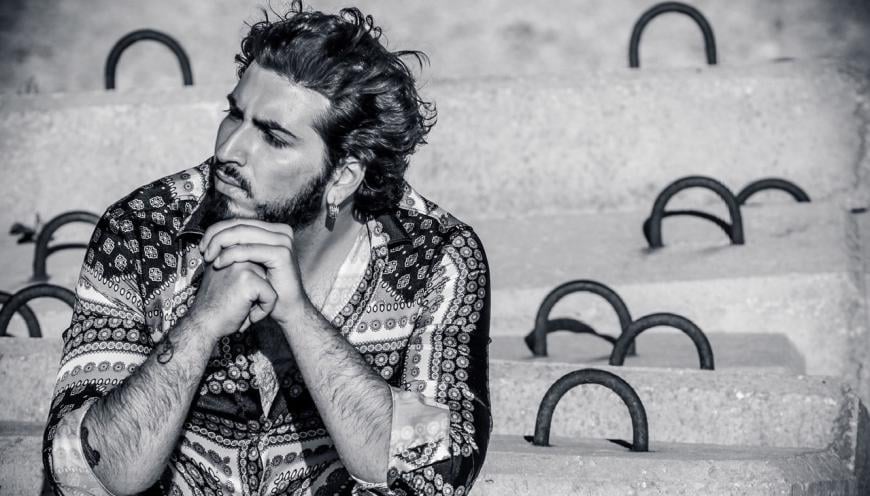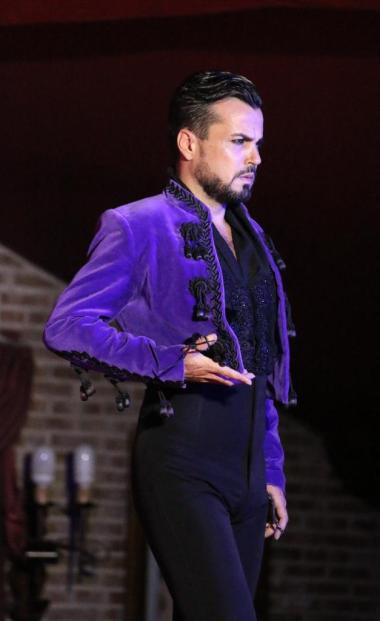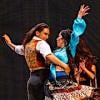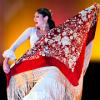
The disorienting sensation of timelessness is a theme running through Theatre Flamenco of San Francisco’s 57th home season, both as a source of transcendent inspiration and a rueful reflection on the past three years.
On the ecstatic side, Carola Zertuche, dancer, choreographer, and artistic director of the Bay Area’s second-oldest dance company, drew from a trip to the ancient desert valley Wadi Rum with her husband’s Jordanian family. The experience of sleeping under a luminous trellis of stars provided the guiding vision for Transitar por un Mundo sin Tiempo (Passage through a timeless world), the evening-length work that Theatre Flamenco premieres Saturday at Herbst Theatre.
“We spent two days and nights in this desert, and it’s like you go to another world,” Zertuche said on a recent video call. “The desert is like the ocean, and sleeping under the stars is like being at sea on a boat. I was very inspired.”
Saturday’s performance marks the company’s return to Herbst for its first home-season production since the pandemic, a formless interim that often felt like inspiration kryptonite. With Transitar, Zertuche seems to be making up for lost time. Devoted to the music’s Gitano cante jondo (deep song) roots, the company continues to explore new sonic territory with a stellar constellation of Spanish collaborators.
Fusing flamenco with live electronic music, violin, trumpet, and electric guitar, the production features world-renowned guitarist Juani de la Isla serving as the evening’s music director. A dauntingly prolific recording artist with some 200 albums to his credit, he hails from the island of San Fernando near the Andalusian port city of Cádiz (a flamenco hotbed for generations).
De la Isla is joined by Diego Amador Jr., a vocalist and multi-instrumentalist from a celebrated clan of Gitano flamenco artists known for melding the Andalusian art form with rock, jazz, and other non-Gitano idioms. His father is the celebrated flamenco vocalist and pianist Diego Amador, and his uncles Raimundo and Rafael founded the groundbreaking 1980s flamenco-blues band Pata Negra (in which their younger brother Diego played drums).

“Diego hijo [Jr.] is an amazing singer and musician,” Zertuche said. “He’s very open to do anything. I worked with him in my studio, and I said, ‘I need you for a show.’”
Three Bay Area musicians round out the instrumental component: trumpeter Mario Silva, electric guitarist Roberto Aguilar, and electronic musician Pascual Martínez, a 20-year-old UC Santa Cruz student who also happens to be Zertuche’s nephew. They’ve been working together in recent months, drawing on flamenco’s roots to create electronic soundscapes from samples and modular synthesizer patches. He’s got a good deal of direct experience with flamenco for reference.
“He’s been coming to see my shows since he was 4,” Zertuche said. “We created the music for the opening number, and he’s creating interstitial music between numbers. Flamenco is very rich. It’s so strong that even if you mix it with other elements, it’s always going to be flamenco.”
Dancer Adrian Santana, who’s making his San Francisco debut with this performance, hails from Málaga, another traditional center of flamenco. He stands out both as an openly gay flamenco artist and a torchbearer for a celebrated family, though he didn’t realize just how deeply his flamenco roots ran until after he studied at the conservatory in Málaga.

A decade ago, developing a new piece for the closing number at the Bienal de Málaga flamenco showcase, Santana “started to search more for a tribute to my family and other artists in Málaga,” he said, speaking from Spain on the video call with Zertuche. He had been taught by his uncle, the esteemed dancer Pepito Vargas, but “I only found out creating that show that another aunt is a singer and lots of family members were also doing flamenco.”
De la Isla, Amador, and Santana are all offering workshops at Theatre Flamenco’s Mission District studio in the days before and after Saturday’s performance. After two years of teaching solely online, Zertuche has been thrilled to be back in person, though she’s still offering remote classes for students around the world.
Transitar features several dancers with deep ties to the company that speak to its essential role in maintaining the Bay Area’s status as a major center for flamenco in the U.S. A member of the celebrated New York company Soledad Barrio & Noche Flamenca since 2012, Marina Elana got her start studying flamenco with Adela Clara, who founded Theatre Flamenco in 1966. She went on to study with leading dancers in Seville and Madrid, including Yolanda Heredia, Belén Maya, Isabel Bayón, and Soledad Barrio.
And Santa Barbara-raised Ysabella Yturralde, a freshman at UC Berkeley, has spent the past year studying with Zertuche. A student of flamenco since the age of 5, she won a scholarship from Spain’s tourist office last year to attend the Festival de Jerez in Jerez de la Frontera and study with Spanish masters.
“It’s been a while since I worked with young people like this,” Zertuche said. “We started to work, and Ysabella picked it up immediately. She really wanted to learn and try new things.”
Trying new things has been a hallmark of the Mexican-born Zertuche’s 16-year tenure at the head of Theatre Flamenco. Under her guidance, the company has been revitalized, toggling between experimentation and tradition, forging deep ties with flamenco’s most celebrated artists while continuing to bring new performers into the fold. More than a return to form after four years away from Herbst Theatre, Saturday’s production is a statement that Theatre Flamenco continues to seek out the leading edge of an art form that depends upon laying bare timeless truths.



